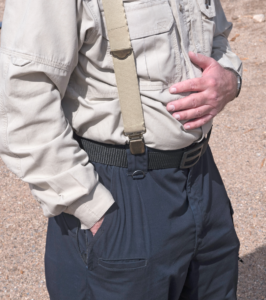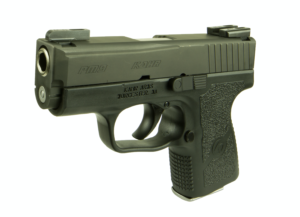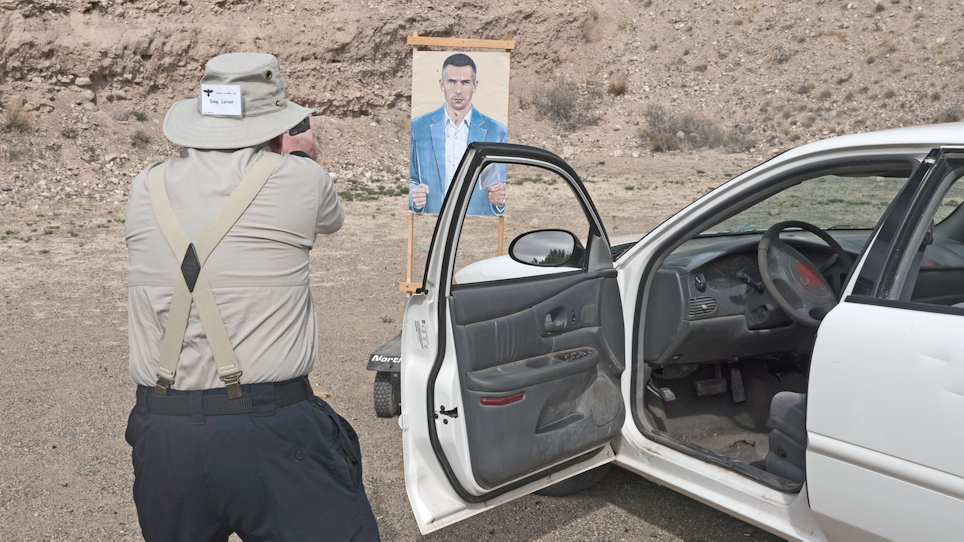Training, like that provided by Gunsite Academy, is critical. Here the author, after exiting a car that is boxed in, engages a moving target representing an attacker with a knife and meat cleaver. It sounds easy, but getting out of the car and drawing from a pocket while under stress is not. (Featured photo: David Bahde)
If you are like most retailers who sell handguns, you are probably selling more guns than ever that are designed for discreet carry techniques.
Almost all states now have laws allowing citizens to carry a gun hidden from view for self protection, and more people are realizing that they are the first responders and must take responsibility for protecting themselves and loved ones until the police arrive. Even the police know that it is rare for a law enforcement officer to be on the scene at the beginning of a deadly force encounter, and that until they arrive, the victim is on his or her own.
There are many handguns available these days for people to carry discreetly for use in self defense. And there are many different ways to carry a handgun so that it is out of sight but ready for use if the need arises. One of the most popular ways of carrying a gun is in a pocket. Even if that is not the primary method a person uses, it is likely that at some time that same person will eventually put a gun in their pocket just because it’s easy and convenient to do.
While pocket carry is common, it is also probably the least understood and most poorly practiced method of carry. People do it casually but have never really thought about safety and drawing the gun quickly. Part of the problem is many instructors don't even know how to do it right and never discuss it in a class. The reality is the carrier can get hurt carrying a gun in a pocket if it is not done correctly.
If it is done correctly, though, it is a safe and effective means of discreet carry. Although drawing from a pocket is usually slower than drawing from a belt-holster hidden by a cover garment like a shirt or jacket, under the right circumstances — if the threat is apparent before actually threatening with deadly force and the pocket carrier can obtain a firing grip before needing to draw — it actually can be faster.
But you must know what you are doing and practice doing it.
TRAINING
Getting the proper instruction is not easy. There are a few places, though, that offer pocket carry training, and one is Gunsite Academy (www.gunsite.com) located near Prescott, Arizona. I recently attended a concealed carry training class at Gunsite where instruction was offered in various concealed carry techniques, including pocket carry.

To draw from the pocket, the first step is to establish a firing grip on the gun while it is in the pocket. Keep the support hand against the stomach, out of the way, and keep the trigger finger straight, off the trigger. (Photo: David Bahde)
Below are some of the things taught at Gunsite. Many of these things can be passed along to your customers to help keep them safe and make them better practitioners of pocket carry, but keep in mind that there is no substitute for proper training and practice under the watchful eye of an experienced instructor. You just can't learn to do it by reading this article, watching a video or reading a book.
The first and most common mistake people make when carrying a gun in a pocket is to just slip it in the pocket. That can be very dangerous in most circumstances and can cause unintentional discharges that can injure the carrier or anyone nearby. Instead of dropping the gun in a pocket, the gun should first be safely inserted into a pocket holster that covers the trigger. Then the gun and holster as a unit are inserted slowly and carefully into the pocket.
Some experienced practitioners of pocket carry will not use a holster, but it is a dicey proposition to go without. And those who do it usually only do so with a revolver that has a bobbed or shrouded hammer and a significantly heavy double- action trigger pull. See, one of the main problems a holster helps to eliminate is the trigger snagging on the edge of a pocket or something else that could cause the trigger to be pulled.
A holster also helps keep the gun oriented in the right position so that when the gun is reached for, the grip is where it should be. Without the holster, it is easier for the gun to move around in the pocket and become oriented the wrong way. A holster also helps to keep the gun clean. Pockets are infested with lint and debris that can easily work into the gun, eventually causing a malfunction.
Also, never put anything besides the gun and holster into the same pocket. Keys, coins and whatnot can work their way into the trigger guard and make the gun go off when it is not wanted.
Holsters for pocket carry are usually made of fabric or leather and feature characteristics that help keep the holster in the pocket while releasing the gun cleanly when drawn. Leather pocket holsters are usually made so the rough side is out and often have a corner hook that catches the pocket when the gun is drawn. Some fabric holsters have a sticky substance on the outside that grips the pocket fabric, but I've seen these holsters come out with the gun and pull the pocket inside-out. I prefer a leather holster.
A number of manufacturers make pocket holsters including Galco and Simply Rugged Holsters. During the class, I carried a Galco Front Pocket Horsehide holster, which worked exceedingly well.
POCKETS
All pockets are not equal. Generally, the garment must be fairly loose fitting and the pocket opening must be large enough to permit a smooth draw. If the pocket opening is too small or the garment is too tight, it will be too hard to cleanly and quickly get the gun out under stress.
Some companies actually make garments designed for pocket carry. One is Concealed Cargo, which makes heavy duty, tactical appearing pants. The pockets are very large. I've seen the company's owner, Brandon Travino, carry and draw a full-size Ruger double-action revolver with a long barrel, and it did not look like he was carrying a gun. Drawing was easy.
Another company is CCW Breakaways that makes normal-looking slacks and jeans with special front pockets that are adjustable for size and have an opening that quickly enlarges when hidden snaps are released during the draw.
The front pockets orient the gun to the inside of the thigh, making any bulges less obvious when compared to normal pants where the pocket is located at the front or outside of the thigh. When used properly, they do a good job of hiding the gun and also allow for a fast and smooth draw.
Often ignored is a good belt. But those experienced in carrying a gun know the importance of a sturdy belt. See the Ultra Carry sidebar for more information and reasons why a retailer should consider stocking this line.

The Kahr PM9 is a little gun that uses six or seven round magazines. But it shoots very well, more like a full size gun, and still fits easily in a pocket. (Photo: Doug Larson)
EQUIPMENT
At Gunsite, I used two guns firing Aguila 9mm ammunition with no malfunctions of any kind.
Kahr is an innovative company that created a line of small guns that have large gun characteristics. The single-stack 9mm Kahr PM9 worked superbly during the class and was easy to draw, holster and pocket safely. Magazine changes went well with either six or seven-round magazines dropping free when the magazine release button was pressed. And with Truglo TFO (Tritium Fiber Optic) sights that glow not only in low light but also in bright sunlight, the sight picture was fast and easy to acquire.
I also tested SIG's slim new P365, a game-changing small pistol about the same size as the Kahr and also in 9mm, but with a magazine capacity of 10 or 12 rounds thanks to a clever double-stack magazine design. The gun is a bit heavier than the PM9, although weight did not present a problem.
The P365 has tritium night sights and a big green dot out front that helps with sight picture acquisition. The P365 performed extremely well, and in fact won the speed draw contest where a steel target is shot in a man-on-man shoot-off. This was against full-size guns carried concealed in belt holsters.

The new SIG P365, while about the same size as the Kahr PM9 in height, length and width, uses 10 or 12 round magazines. This approaches the capacity of a full size gun, yet the P365 still carries well in a pocket. (Photo: Sig Sauer)
SPARE AMMO
Often, a pocket carry practitioner will neglect to carry extra ammunition. This is a mistake that is easily corrected. If carrying a revolver, Quick Strips made by Tuff Products keep rounds together and conveniently carried in a pocket without creating a bulge. For semi-automatic handguns, magazines can be carried in a pocket pouch that can be inserted into a pocket. When in a back pocket, it resembles a man's wallet and draws no unwanted attention.
With the increased frequency of terrorist and gang attacks involving multiple assailants, having spare ammunition is important. And malfunctions due to faulty magazines are common, so having spares is a must.
By helping your customers know how to carry a gun properly, you help make safer gun owners. And you will have the opportunity to increase profit by selling them the equipment they need, like holsters, magazine pouches, clothing and belts.
NEW CARRY BELT
A sturdy and stiff, yet flexible, heavy-duty belt is a must when carrying a gun on the belt or in a pants pocket. A gun belt suspends the weight and spreads it evenly around the waist, while helping to keep the gun and holster in position without the trouser waistband sagging.
But stocking a line of belts is a problem for the retailer. A variety of waist sizes are required, and when different colors and belt styles are added to the mix, the number of SKUs multiplies. More showroom shelf space and back room storage area is needed.
The new Ultra Carry Belt from Blade-Tech solves these problems. The stylish yet utilitarian 1½-inch-wide Ultra Carry Belt is built for everyday wear, so will appeal to most customers. And you need stock only four SKUs to cover all waist sizes from 25 inches to 50 inches. The customer chooses black or brown leather, or black or tan nylon, cuts the belt to the desired length, attaches the belt buckle and he's ready.
Instead of holes for the belt buckle, a set of reinforced polymer teeth hidden on the back side of the belt engage a ratchet. This allows the wearer to adjust the belt throughout the day for comfort – without taking off the belt. The belt is strong, rated for 1,300 pounds tensile strength.
I wore one constantly at Gunsite during the class and was very satisfied with the performance. The instant adjustment feature made it comfortable for day-long wear, and it looked great, too.






